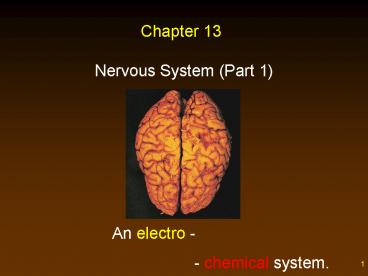Nervous System (Part 1) - PowerPoint PPT Presentation
Title:
Nervous System (Part 1)
Description:
Chapter 13 Nervous System (Part 1) An electro - - chemical system. * * Computer Assisted Tomography (CAT) scan * Magnetic Resonance Imaging (MRI) scan * * The ... – PowerPoint PPT presentation
Number of Views:119
Avg rating:3.0/5.0
Title: Nervous System (Part 1)
1
Chapter 13
- Nervous System (Part 1)
An electro -
- chemical system.
2
Review
- Overview of the Nervous System
- Central Nervous System
- The Spinal Cord
- The Brain
- The Limbic System and Higher Mental Functions
- Peripheral Nervous System
- - Somatic / Autonomic Systems
- Drug Therapy and Drug Abuse
3
Overview of the Nervous System
4
- Nervous system function?
- allows us to receive, integrate (process), and
react to environmental stimuli to maintain
homeostasis. - Component parts?
- Central nervous system (CNS)
- includes the brain and spinal cord
- Peripheral nervous system (PNS)
- Somatic sensory and motor neurons to skeletal
muscles (voluntary) - Autonomic sensory and motor neurons go to smooth
muscles and glands (involuntary)
5
(No Transcript)
6
Nervous Tissue
- Nervous Tissue contains two types of cells.
- Neurons transmit nerve impulses between parts of
the nervous system. - Neuroglia support, protect, and nourish neurons.
(neuroglial cells or glial cells) - Have different specific names based on their
shape, location, function.
7
(No Transcript)
8
(No Transcript)
9
(No Transcript)
10
Neuron Structure
- Neurons are classified according to function.
- Sensory neurons take impulses from a sensory
receptor to the CNS. (afferent, at) - Interneurons receive input from sensory neurons,
and other neurons, and then communicate with
motor neurons. (association, connector) - Motor neurons take nerve impulse away from the
CNS to an effector that carries out responses to
environmental change. (efferent, exit)
11
Types of Neurons
12
Neuron Structure
- Neurons contain three basic parts.
- Cell body contains nucleus and other organelles.
- Dendrites receive signals from sensory receptors
or other neurons. - Axon conducts nerve impulses away for the cell
body.
13
Myelin Sheath
- Some axons are covered by a protective myelin
sheath. - Formed by Schwann cells containing myelin in
plasma membranes. - (neurolemmocytes)
- Nodes of Ranvier are gaps on the axon with no
myelin sheath. (neurofibril node)
14
(No Transcript)
15
Myelin Sheath
16
(No Transcript)
17
The Nerve Signal
- The nervous system uses the nerve impulse to
convey information. - Resting potential is the voltage level when an
axon is not conducting an impulse. - Sodium-potassium pump causes greater
concentration of Na outside the axon, and
greater concentration of K inside the axon. - Unequal ion distribution causes inside of axon to
be negative relative to the outside.
18
(No Transcript)
19
Action Potential
- An action potential is a rapid change in polarity
across an axomembrane as the nerve impulse
occurs. - All-or-none once threshold is reached.
- Sodium gates open, allowing Na to move inside
the axon. - Potassium gates open, allowing K to move outside
the axon. - The charge flips becomes on the inside, (-)
on the outside . . .
20
(No Transcript)
21
Propagation of an Action Potential
- Each preceding portion causes an action potential
in the next portion of an axon. - Rather than moving continuously along the axon,
the electrical impulse jumps from node to node
saltatory conduction. - As soon as an action potential has moved on, the
previous portion of an axon undergoes a
refractory period in which the sodium gates are
unable to open thus the impulse can only move
away from the cell body.
22
(No Transcript)
23
The Synapse
- Transmission across a synaptic cleft is carried
out by neurotransmitters stored in synaptic
vesicles (which are released into the cleft
because of the release of Ca) - norepinephrine
(NE) or acetylcholine (ACh). - Depending on the neurotransmitter and the
receptor, the response of the postsynaptic neuron
can be towards excitation or inhibition summary
(net) effect. - Integration is the summing of signals received by
a postsynaptic neuron.
24
(No Transcript)
25
(No Transcript)
26
Synaptic Integration
27
Historical Focus
- Artist and Scientist Santiago Ramon y Cajal
(1852-1934)
28
The Central Nervous System
- The central nervous system (CNS) is made up of
the spinal cord and the brain. - Both are wrapped in protective membranes,
meninges, with spaces between meninges filled
with cerebrospinal fluid which also fills 4
cavities in the brain (called ventricles) and act
as reservoirs. - CNS is composed of two types of nervous tissue.
- Gray matter Short, nonmyelinated fibers.
- White matter - Myelinated axons.
29
(No Transcript)
30
(No Transcript)
31
(No Transcript)
32
(No Transcript)
33
(No Transcript)
34
Computer Assisted Tomography (CAT) scan
35
Magnetic Resonance Imaging (MRI) scan
36
(No Transcript)
37
The Spinal Cord
- The spinal cord extends from the base of the
brain through the foramen magnum into the
vertebral canal. - Components
- Central canal filled with cerebrospinal fluid
- Grey matter butterfly shaped
- White matter contains interneurons grouped in
tracts (ascending and descending) which cross
over so that left side of brain controls right
side of body.
38
(No Transcript)
39
Functions of the Spinal Cord
- The spinal cord (1) provides a means of
communication between the brain and the
peripheral nerves that leave the cord - and (2) is a center for reflex actions.































